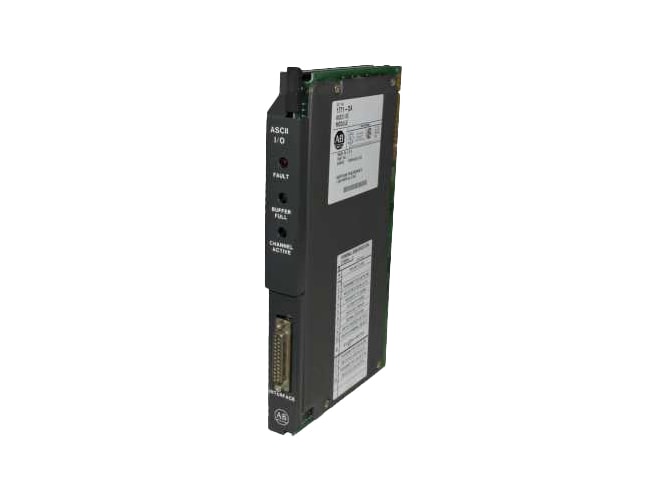Repair Allen-Bradley 1771-DA PLC-5 ASCII I/O Module
1.5K words buffer memory.

Remanufactured
-
1 in stock
- 1771-DAREP
Overview
Features
- User selectable communication rates:
- 110, 300, 600, 1200, 2400, 4800, 9600 baud
- 1.3A backplane current requirement
- Between 8 and 10, and between 30 and 32 keying
- Passive receive circuit (pins 12 and 24):
- Isolation:
- 3,000VDC between customer and PC system circuitry
- 500V/us common mode transient immunity
- Input current range:
- 4.0mA to 20.0mA for mark state
- 0.0mA to 0.5mA for space state
- Nominal input voltage range:
- 1.51V @ 4mA to 2.05V @ 20mA for mark state
- 0.0V to 1.10V @ 0.5mA for space state
- Reverse input voltage limit:
- 5.0V between pins 12 and 24
- No reverse voltage protection
- Isolation:
- Active transmitter circuit (pins 13 and 11):
- 500VDC isolation between customer and PC system circuitry
- Input current range:
- 23.0mA max for mark state (load must exceed 300 ohms)
- 0mA for space state
- Passive transmitter circuit (pins 11 and 18):
- 500VDC isolation between customer and PC system circuitry
- Device and power supply must float referenced to module ground
- Input current range:
- 55.0mA max. for mark state (max. voltage across pins 11 and 18 is 2.29, nominal is 1V@20mA)
- 0mA for space state
- 2.7V reverse voltage limit across pins 11 and 18
Description
The Allen-Bradley 1771-DA PLC-5 ASCII I/O Module can transfer data, by means of an I/O scan, from an ASCII device to a PC processor data table, and vice versa. The module has two modes of operation, data mode and report generation mode. In data mode, the user can transfer ASCII, BCD, or hex characters. Generally, this mode can be used to transfer data to the processor data table. In report generation mode, the user can include BCD values in the string of ASCII characters. Generally, this mode can be used to transfer messages.
The ASCII module can be used with any Allen-Bradley programmable controller that has an expandable data table, block transfer capability, and uses the 1771 I/O structure. If a PLC-2/20 controller is used, the programming will be lengthier as its processor does not have file move or block transfer instructions.
Need Help? Call an expert at 1-704-702-6380
We're open Mo-Fr 8:00am to 5:00pm














